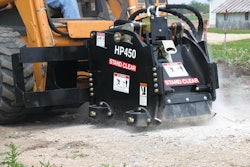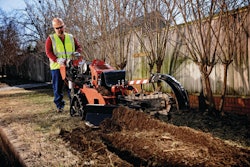
While every position is critical within a construction company, certainly the role of president is one that garners a lot of attention, requires a great amount of energy and needs an ever greater amount of discipline to fulfill effectively. Work hard and make the right decision as to whom your next president might be. Using the items presented in this article, combined with an understanding of “presidential focus” from a previous article, will give you greater clarity as to what that person will need and be exposed to.
So, without any further ado, rely on these 10 steps in the Making of a construction president.
1. Define what the president is to do and be
For the contractor who is hiring a president from outside the company, it is clearly a mandate that a well-defined roles and responsibilities description be developed. This same effort also is just as critical for the president who is promoted from within. I have found many companies that promote from within who do a poor job of clarifying what the president’s role is to be.
This, I think, is done out of some subliminal thought that thinks, “Well, he’s been here a while and knows what the last president did.” Not only is this wrong thinking, it’s a disservice to the new president and sets lower expectations among those who will be following the new president.
A clear definition of what the president will be doing and what he or she will be representing for the company needs to be formalized and made known to the entire company. Anytime a new leader is announced, especially when the leader is the president, it is time to “clean the slate” and clarify what this new leader’s position and focus will be.
2. Engage your president in local “presidents’ forums”
One of the loneliest jobs in a construction company is the position of president. Even for the “home grown” president, one who has known the company most of his or her working life, the role can suddenly make strangers of some people and leave the president often wondering “who can I trust and who will tell me what I want to hear.”
Participating in a local group made up of other company presidents, no matter the industry, can often provide a safe outlet for the new president to exchange experiences with others in similar situations. Best practices and lessons learned can provide invaluable education for the new president, often preventing the president from making mistakes others have made.
3. Provide a strong and competent finance leader
Any president will quickly confess that having the right financial information about the company and how it is performing is key to making the best decisions. If your company has a good finance leader then encourage this individual and the new president to spend a lot of time together getting the president up to speed on the financial picture of the company.
If your company does not have a strong finance leader, and you can afford to hire one, do it ASAP! That’s how important it is for the president to have timely, accurate and unbiased numbers available.
Contracting with a local financial expert would not be totally out of the question if this were your only option. It’s also not a bad idea at all to provide the president with some strong finance education. Many of the presidents I’ve worked with over the years greatly appreciated the deeper level of knowledge about finances, and it placed them at a more intelligent stage to hold conversations with other financed-based leaders in the community.
4. Contract with an executive coach for professional development
It continues to amaze me how many construction presidents are still scared to speak in front of a group of people or who fumble when it comes to facilitating a meeting. While the president isn’t expected to be a keynote speaker he or she is expected to present a strong and confident presence whether speaking personally with another individual or before a room with an audience.
The use of a coach can provide a confidant for the president and one who should challenge them with professional improvement training and even address personal “presence” if needed. Under this system of development the president should be introduced to communication skills and decision-making skills, learn how to conduct a meeting, learn how to challenge his or her leaders, learn how to bring the team to a decision, and any number of other skills.
5. Emphasize strategy over tactics…always!
I’ll get some argument from some presidents on this but I still find way too many presidents, no matter the size of company, who are quick to go tactical rather than focus on the strategic. Admittedly, this can be a difficult development to accomplish, but it is one that must be continued for the long-term success of the company. Remember, a strategic mindset takes a larger view of a developing situation and considers the long-term and short-term advantages, disadvantages, options and consequences.
So, what are a few learning efforts needed to develop a more strategic presence of mind? Try a few of these:
- Expose the president to strategic thinking and planning literature
- Have the president network with other companies that are engaged in strategic planning
- Conduct your own strategic retreat as early in the new president’s “first term” as possible
- Have your new president consider a 1-, 3-, and 5-year view of how he or she sees the company growing
Remember, it is strategic thinking that often keeps construction companies from moving “south” to mediocrity and challenges them to move from “good to great” in their efforts and results.
6. Build the team: both as facilitator and “player”
The president must be engaged with the senior leaders and key personnel throughout the organization. So it is critical that your president becomes skilled at building a team atmosphere. This doesn’t suggest that he or she needs to take the team on a float trip down a river or have them jump into each other’s arms, but it does suggest that the president needs to know how to move people to work together.
The president needs to know both how to lead or facilitate a team as well as how to be a team member. On a number of occasions the president will be part of meetings where the decision needed should come from other leaders. In this case, the president should restrain himself or herself from being too overbearing or micromanaging and support a direction, as any team member would be expected.
7. Engage any new president in business development opportunities
This development effort is almost too easy to include, but many new presidents do not understand just how many evenings might be spent with nonfamily members at dinners, awards banquets, and supplier or union dinners. Not all presidents are cut from the same cloth for sure, but a new president will need to be more visible and engaged with building up the business.
While a president might seldom make a “cold call” with your company’s sales person or estimator, he or she should be prepared to spend the time necessary to build customer relationships and win more business.
Again, you might have the most talented of marketing, estimating and business development people working for your firm BUT, you take a president along for that customer interview or presentation and the entire tone of the meeting can become more alive and enthusiastic for the customer. Thus, getting our new president some sales skills and coaching on what to say and what not to say on a sales call could go a long way toward making your president the final “knock out” punch needed to land more work.
8. Maintain field/site visits with company crews
It’s truly amazing when a new president can still find the time to visit work crews at jobsites. For the president of a small business, this might not be as difficult to accomplish. It begins to be more difficult to “stay in touch” when the president soon realizes the other tasks and commitments. Never forget the motivational impact a president’s visit can have on your workers.
9. Continue learning about health care and its impact on your company
The plethora of information and articles continues to astound me, but the new construction president must get his or her arms around this topic because it will be an annual review topic, one affecting budgets and how we might go about hiring in the future. The president will need to be engaged with reading literature that is directed at any health care policies affecting you and your company, depending on the size of company that you have. While there is a lot of information available on the Internet, it is still wise to provide some clear and accurate resources that will allow your president to make better-educated decisions for the company.
10. Focus on being a true “professional”
My wife took all of about five minutes to recognize the president of a client of mine when he walked in the room. It wasn’t his chatty nature (he’s reserved) and it wasn’t his huge physical build (he’s actual slim and non-threatening) but rather it was the way in which he carried himself. He walked confident, shoulders back, but not out to impress; rather, he displayed a quiet confidence in his own abilities, not needing to prove himself to others.
There are many ways to define a professional, but here are few observations that might work to build into your new president’s professional presence:
- Make eye contact with others when interacting
- Teach the discipline of shaking hands strong and confident (not the “high 5” or “fist pump”)
- Slow down the pace when in a room; spend a few extra moments with folks; don’t be in a hurry
- Work on name memorization…It really lights people up when you remember their name
- Teach the president to ask others about what they do or what struggles the other person is facing (Remember, it’s not about “me”)
- Be consistent and quick to always say “Thank You”
- Smile!
Making a professional impression on others will in the end lead to more respect for your company, more loyal contractors who will want to work with or for you, and ultimately, more customers who will remain loyal to your construction company.
Like all senior level leaders, there are a host of other topics on which the president should be educated, including:
- Stay updated on high-tech developments
- Stay updated on construction improvements
- Learn more about the differences among people
- Stay updated on health, environment and safety issues
- Build relationships with other contractors
- And plenty more…
In the selection of your next president, consider the level of confidence you will need in this position. Will that individual make a good president? Will he or she have the needed “thick skin” and mental discipline to make the position a strong role for your company?
Since almost 99.9% of contractors are family businesses it is almost a foregone conclusion that a family member will be the next president. Before you go too far down this road, however, look back over some of the points presented above. It is far better for your company that the individual, “blood or not,” is built with many of the before mentioned skills, traits and desires. The son or daughter that you always thought would be the president might just be more successful doing something else for the company.



















